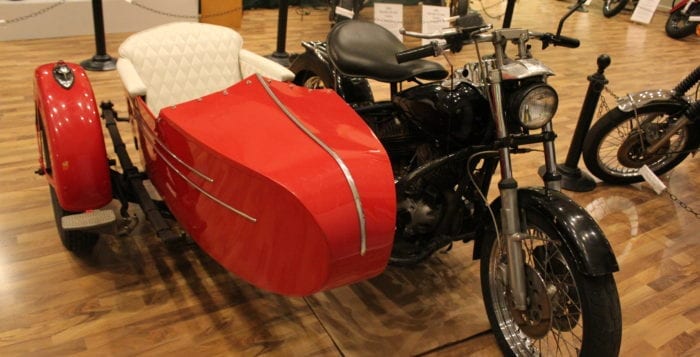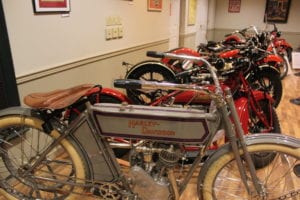
By Kevin Redding
For as long as they’ve been around, motorcycles and their riders have encapsulated the American spirit. Beyond the fact that anybody straddling a chrome-plated hog immediately becomes unanimous with “cool,” the motorcycle has always represented independence, escape, toughness, rebellion and freedom. Unlike drivers encased in their cars, bikers glide down the open road with a ferocious and liberating intimacy with themselves and all that surrounds them, surveying the world in a constant state of high-speed danger and adrenaline all at once. The ultimate thrill seekers, the motorcycling community is certainly a breed apart from the rest. And they’ve helped shape American culture as a result.
Whether it was Steve McQueen jumping over barbed wire fence on his iconic Triumph TR6 Trophy in “The Great Escape” or Peter Fonda cruising on his “Captain America” Harley Davidson in “Easy Rider,” the allure of hopping on a chopper and putting the pedal to the metal has sustained generations.
The times may have changed and the bikes might look different, but motorcycle culture is still alive and well and is currently being celebrated in Stony Brook Village.

Devoted bikers and nonbikers alike can go explore Motorcycles and the Open Road, a summer exhibit that will run through Sept. 5 at the Ward Melville Heritage Organization’s Educational & Cultural Center. Building on the success of its two previous motorcycle exhibits, the center offers over 50 bikes on display and will contain a completely different batch than the ones seen last year, with the exception of a crowd-pleasing 1911 Harley Davidson.
Visitors will be treated to a wide variety of motorcycles throughout history — ranging from 1904 to 1997 — as well as iconic artwork by David Uhl, bronze sculptures by Jeff Decker and vintage memorabilia like helmets and signs.
The earliest bikes on display are a 1904 Rambler courtesy of Jim Giorgio, which looks like a regular bicycle with a motor attached, and a 1907 Indian, which once belonged to Henry Wing Sr., one of the founders of the Antique Motorcycle Club of America. This particular bike is known for its “camelback” look.
“[The motorcycles] are very artistic, and there’s a lot of historical importance between different decades and different manufacturers,” said Stephanie Ruales, special events coordinator for the center. “Older generations obviously love seeing them because it reminds them of something they maybe grew up with. And the younger kids … can’t really deny that the bikes are just cool to look at. I think when you start in the early 1900s and see what they were and what they evolved into, older and younger generations can appreciate them,” she added.
As visitors continue through the gallery, they will notice the aesthetic evolution of the motorcycles. Heading into the ’30s and ’40s, manufacturers bulked up the bikes, spruced up the designs and started engineering the motorcycles for what the public may have wanted at that specific time. Motorcycle brands were, and still are, constantly changing year to year due to ever-evolving styles, so it’s fascinating to see the gradual change over the course of the 20th century.
Among the most noteworthy bikes on display are a 1931 Indian Four, which is a rare Depression-era motorcycle that scored a 97 out of 100 at its judging at the Antique Motorcycle Club of America, making it quite the elite ride; a 1934 Harley Davidson, which was featured at Harley’s factory in Milwaukee in 2003 for its 100th anniversary; and a 1950 BMW R51/2, which came in the aftermath of Germany’s ban on producing motorcycles of any sort post-World War II. Even though the ban was ultimately lifted, all of their designs, blueprints and schematic drawings were gone and they had to start from scratch, left to use surviving prewar parts to build a new bike.
Aside from Suzukis and Ducatis, fans of newer designs will enjoy the 1982 Honda CX500 Turbo, which looks like something straight out of a sci-fi film. “[All of the motorcycles] come from Long Island. They all come from different Long Island collectors and private owners. We also have a dealership that was very gracious to loan us some of their bikes as well. And people are very enthusiastic about putting their motorcycles on display for everyone to appreciate,” said Ruales.
One of the more unique displays is the “Precious Metal,” a custom motorcycle made by Copper Mike from Lindenhurst and chosen by Lady Gaga to be onstage at her “Born This Way” album release at Union Square in 2011.
Visitors can also take part in a virtual ride of sorts, when they sit down on an old Harley and inside its sidecar and cruise past the rolling hills of Ireland, which is projected on the screen in front of them.
Not being a motorcycle enthusiast is no reason to skip this exhibit. “We get people that come in and say they don’t know anything about the motorcycles … and they come through and find something they can appreciate,” said Ruales.
The Ward Melville Heritage Organization will present Motorcycles and the Open Road now through Sept. 5 at its Educational & Cultural Center, 97P Main Street, Stony Brook. The exhibit, partially sponsored by Astoria Bank, is open seven days a week from 10 a.m. to 5 p.m. Admission is $5 for adults, and $3 for children under 12. For a full schedule of exhibit events, call 631-689-5888, or visit www.wmho.org.






